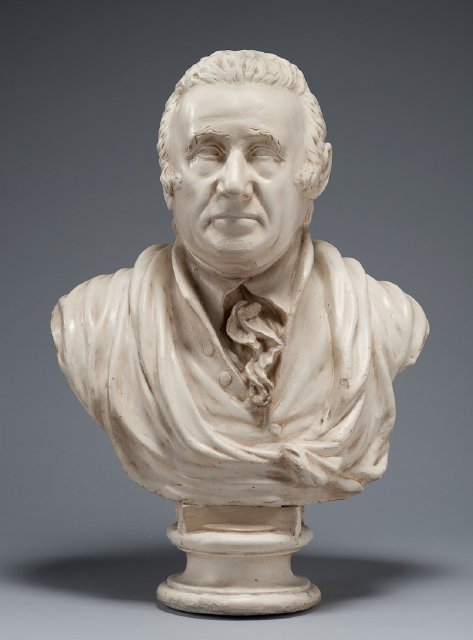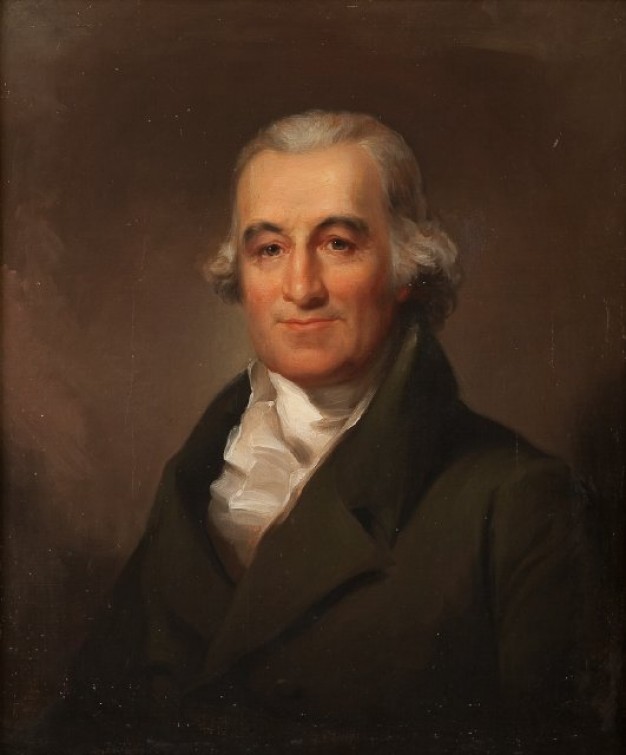The Venerated Doctor’s Portrait
Above image: Thomas Sully after Bass Otis, Caspar Wistar, 1830 (original 1817). Oil on canvas. APS.
If you have spent time in the second-floor conference room of Philosophical Hall, you may have noticed a portrait hanging over the mantel on the right side of the room. Or perhaps not – as portraits go, this one is fairly unremarkable upon first glance: an older man with gray hair wears a plain black jacket and appears against a plain brown background. There is no flashy costume or prop.
But that was precisely the point. The modest portrait is of Doctor Caspar Wistar (1761-1818), President of the American Philosophical Society from 1815-1818. The APS commissioned the portrait in 1830 because the members were “desirous of having constantly before their eyes, the image of their venerated president.” Wistar was also a member and president of the Society for the Abolition of Slavery, involved with the Pennsylvania Prison Society (concerned with prison reform and prisoner rehabilitation), the Humane Society, and the Society for Circulating the Benefit of Vaccination. In 1791 Wistar bought and then freed an enslaved man "to extricate him from that degraded Situation." He was a faculty member of the University of Pennsylvania and worked at the Pennsylvania Hospital. During the yellow fever epidemic of 1793, he stayed in the city to care for the sick. By all accounts, Wistar was a kind doctor and philanthropist, serving the people of Philadelphia.
Sully removed the chair that appears in the original portrait, putting the focus entirely on Wistar and his character. To our modern eyes, the portrait of Doctor Wistar may not be eye catching or particularly interesting, but upon further reflection, the portrait can actually tell us quite a bit about Wistar and the qualities that his contemporaries found worthy of admiration.
Wistar wears a well-made but plain black jacket over a snowy white cravat and shirt. His hair is plainly styled. The simple background further suggests modesty. The effect of his appearance is a man who is comfortably wealthy but not ostentatious. Smiling was not fashionable in portraiture. Refined people were expected to have control over their emotions and bodies at all times, which is why most people have stern countenances in their portraits. Wistar’s expression is therefore the epitome of a gentleman. However, his mouth is slightly turned up and his eyes are creased in a friendly expression. He looks directly out at the viewer, but his body is slightly angled so that his posture is open and non-confrontational. The overall effect of the portrait is that Wistar appears as a well-to-do, well-mannered, self-controlled, but approachable gentleman.

In 1818, upon Wistar’s death, the APS acquired a plaster bust portrait of him. The bust shows Wistar with a heavier jaw and a mouth in a straighter line than in Sully’s later oil portrait. His hair is also cropped shorter. The overall effect is a less approachable, but more monumental figure. The three-dimensional medium adds gravitas to his portrait, as does the classically-draped fabric over his shoulders. The bust presents Wistar as a formidable figure, literally placing him on a pedestal to admire.
Both portraits present Caspar Wistar as a man worthy of admiration, but the painting presents him as a less intimidating figure, probably more in line with Wistar’s personality. Hanging in Philosophical Hall, the venerated APS president unobtrusively welcomes all visitors with a slight smile and friendly face.


